英语国家概况串讲讲义
- 格式:ppt
- 大小:981.00 KB
- 文档页数:18
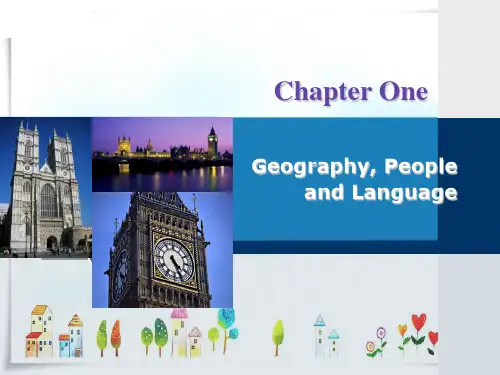
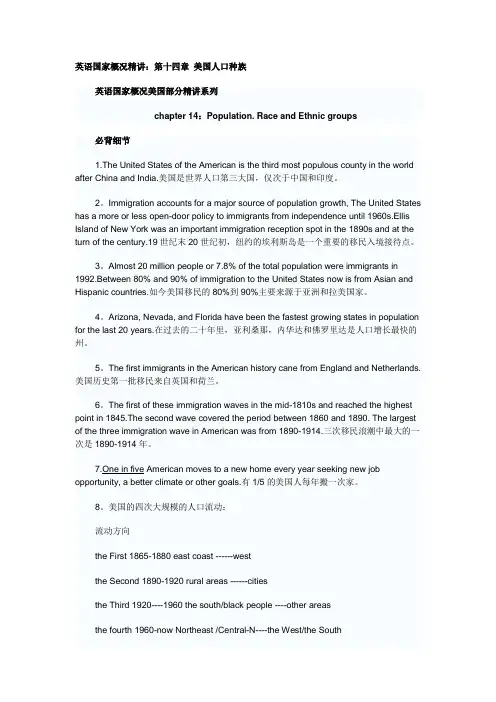
英语国家概况精讲:第十四章美国人口种族英语国家概况美国部分精讲系列chapter 14:Population. Race and Ethnic groups必背细节1.The United States of the American is the third most populous county in the world after China and India.美国是世界人口第三大国,仅次于中国和印度。
2。
Immigration accounts for a major source of population growth, The United States has a more or less open-door policy to immigrants from independence until 1960s.Ellis Island of New York was an important immigration reception spot in the 1890s and at the turn of the century.19世纪末20世纪初,纽约的埃利斯岛是一个重要的移民入境接待点。
3。
Almost 20 million people or 7.8% of the total population were immigrants in 1992.Between 80% and 90% of immigration to the United States now is from Asian and Hispanic countries.如今美国移民的80%到90%主要来源于亚洲和拉美国家。
4。
Arizona, Nevada, and Florida have been the fastest growing states in population for the last 20 years.在过去的二十年里,亚利桑那,内华达和佛罗里达是人口增长最快的州。
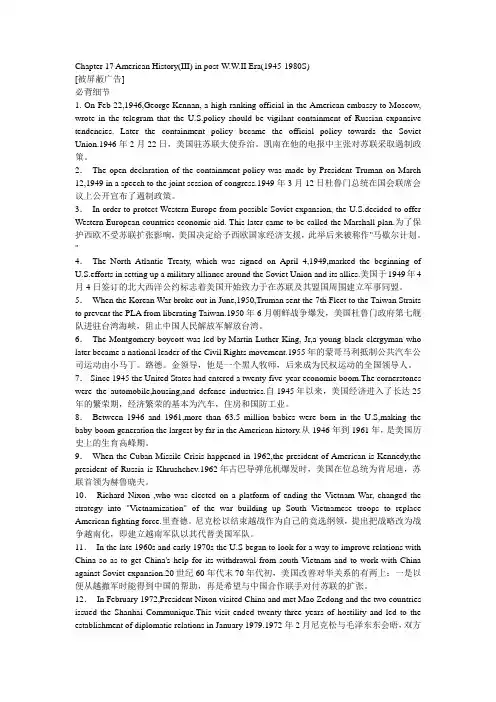
Chapter 17 American History(III) in post-W.W.II Era(1945-1980S)[被屏蔽广告]必背细节1. On Feb 22,1946,George Kennan, a high-ranking official in the American embassy to Moscow, wrote in the telegram that the U.S.policy should be vigilant containment of Russian expansive tendencies. Later the containment policy became the official policy towards the Soviet Union.1946年2月22日,美国驻苏联大使乔治。
凯南在他的电报中主张对苏联采取遏制政策。
2.The open declaration of the containment policy was made by President Truman on March 12,1949 in a speech to the joint session of congress.1949年3月12日杜鲁门总统在国会联席会议上公开宣布了遏制政策。
3.In order to protect Western Europe from possible Soviet expansion, the U.S.decided to offer Western European countries economic aid. This later came to be called the Marshall plan.为了保护西欧不受苏联扩张影响,美国决定给予西欧国家经济支援,此举后来被称作"马歇尔计划。
"4.The North Atlantic Treaty, which was signed on April 4,1949,marked the beginning of U.S.efforts in setting up a military alliance around the Soviet Union and its allies.美国于1949年4月4日签订的北大西洋公约标志着美国开始致力于在苏联及其盟国周围建立军事同盟。
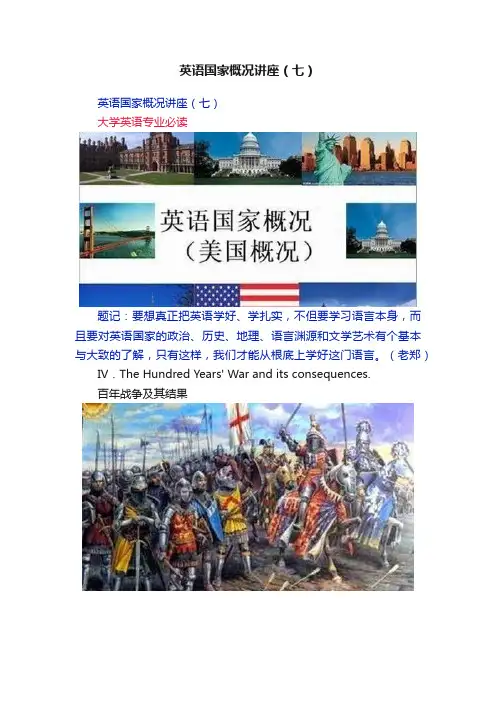
英语国家概况讲座(七)英语国家概况讲座(七)大学英语专业必读题记:要想真正把英语学好、学扎实,不但要学习语言本身,而且要对英语国家的政治、历史、地理、语言渊源和文学艺术有个基本与大致的了解,只有这样,我们才能从根底上学好这门语言。
(老郑)IV.The Hundred Years' War and its consequences.百年战争及其结果The Hundred Years’ War refers to the war between England and France that lasted intermittently from 1337 to 1453. The causes of the war were partly territorial and partly economic. The territorial causes were related with the possession by the English kings of the large duchy in France, while the French kings coveted this large slice. The economic causes were connected with cloth manufacturing towns in Flanders, which were the importer of English wool, but they were loyal to the French king politically. Besides, England's desire to stop France from giving aid to Scots and a growing sense of nationalism were the other causes.The English's being driven out of France is regarded as a blessing for both countries. If the English had remained in France, the superior size and wealth of France would have hindered the development of a separate English national identity, while France was hindered so long as a foreign power occupied so much French territory.百年战争指1337年到1453年英法之间一场断断续续的战争,战争的起因既有领土因素又有经济因素。
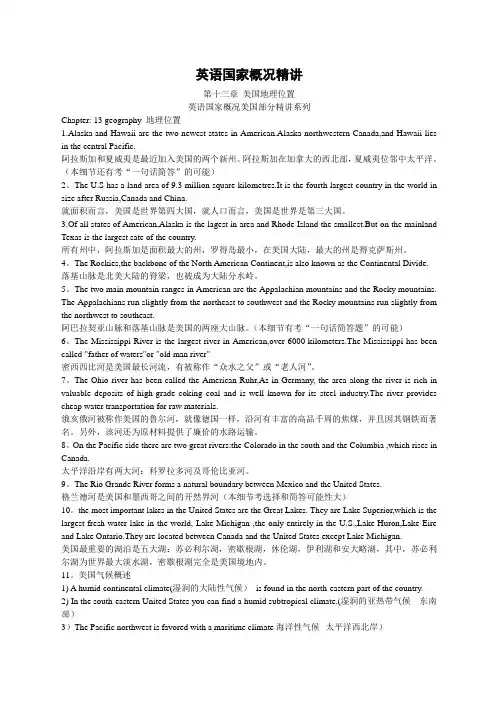
英语国家概况精讲第十三章美国地理位置英语国家概况美国部分精讲系列Chapter: 13 geography 地理位置1.Alaska and Hawaii are the two newest states in American.Alaska northwestern Canada,and Hawaii lies in the central Pacific.阿拉斯加和夏威夷是最近加入美国的两个新州。
阿拉斯加在加拿大的西北部,夏威夷位邻中太平洋。
(本细节还有考“一句话简答”的可能)2。
The U.S has a land area of 9.3 million square kilometres.It is the fourth largest country in the world in size after Russia,Canada and China.就面积而言,美国是世界第四大国,就人口而言,美国是世界是第三大国。
3.Of all states of American,Alaska is the lagest in area and Rhode Island the smallest.But on the mainland Texas is the largest sate of the country.所有州中,阿拉斯加是面积最大的州,罗得岛最小,在美国大陆,最大的州是得克萨斯州。
4。
The Rockies,the backbone of the North American Continent,is also known as the Continental Divide.落基山脉是北美大陆的脊梁,也被成为大陆分水岭。
5。
The two main mountain ranges in American are the Appalachian mountains and the Rocky mountains. The Appalachians run slightly from the northeast to southwest and the Rocky mountains run slightly from the northwest to southeast.阿巴拉契亚山脉和落基山脉是美国的两座大山脉。
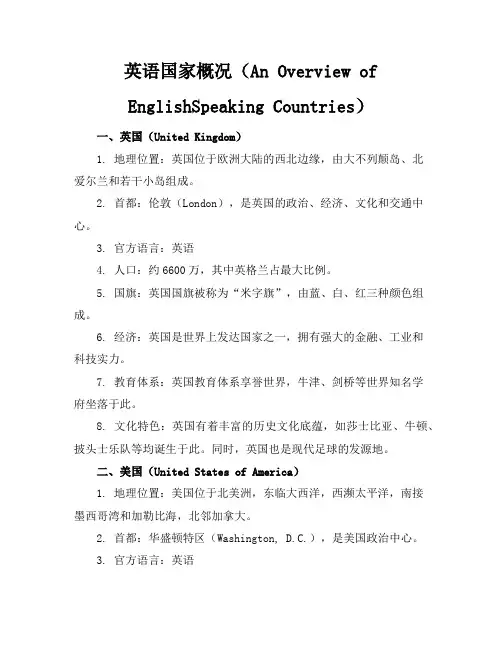
英语国家概况(An Overview ofEnglishSpeaking Countries)一、英国(United Kingdom)1. 地理位置:英国位于欧洲大陆的西北边缘,由大不列颠岛、北爱尔兰和若干小岛组成。
2. 首都:伦敦(London),是英国的政治、经济、文化和交通中心。
3. 官方语言:英语4. 人口:约6600万,其中英格兰占最大比例。
5. 国旗:英国国旗被称为“米字旗”,由蓝、白、红三种颜色组成。
6. 经济:英国是世界上发达国家之一,拥有强大的金融、工业和科技实力。
7. 教育体系:英国教育体系享誉世界,牛津、剑桥等世界知名学府坐落于此。
8. 文化特色:英国有着丰富的历史文化底蕴,如莎士比亚、牛顿、披头士乐队等均诞生于此。
同时,英国也是现代足球的发源地。
二、美国(United States of America)1. 地理位置:美国位于北美洲,东临大西洋,西濒太平洋,南接墨西哥湾和加勒比海,北邻加拿大。
2. 首都:华盛顿特区(Washington, D.C.),是美国政治中心。
3. 官方语言:英语4. 人口:约3.3亿,是世界上第三人口大国。
5. 国旗:美国国旗被称为“星条旗”,由红、白、蓝三种颜色组成。
6. 经济:美国是全球最大的经济体,拥有强大的科技创新能力和金融市场。
7. 教育体系:美国教育资源丰富,世界顶尖大学如哈佛、斯坦福等均位于此。
8. 文化特色:美国文化多元化,涵盖了欧洲、亚洲、非洲等多种文化元素。
好莱坞电影、NBA篮球、美式足球等在全球具有广泛影响力。
三、加拿大(Canada)1. 地理位置:加拿大位于北美洲北部,东临大西洋,西濒太平洋,北接北冰洋,南邻美国。
2. 首都:渥太华(Ottawa),是加拿大的政治中心。
3. 官方语言:英语和法语4. 人口:约3800万,是世界上面积第二大国家。
5. 国旗:加拿大国旗被称为“枫叶旗”,由红、白两色组成。
6. 经济:加拿大经济发达,资源丰富,特别是石油、天然气和矿产资源。

主要英语国家概况说课稿(优秀版)word资料尊敬的各位专家,领导,全体同行:大家好!今天我所选择的说课教材为,《主要英语国家概况》--- 主编谢福之外语教学与研究出版社20XX年八月出版。
我的说课分为如下几部分:一.课程目标二.课程在人才培养方案中的地位三.课程资源四.课程设计实施五.课程评价六.课程建设和改革思路课程目标《主要英语国家概况》是我院应用英语专业必修课;课程类别是专业课。
了解主要英语国家的地理概况;了解这些国家的气候特点;了了解人口分布及风土人情。
熟悉主要英语国家的政体及政治制度、对外尤其是对华;熟悉这些国家的文化发展状况。
掌握主要英语国家的经济发展模式、经济体制及;掌握政体的更迭对国家经济的影响;掌握文化差异对政治的影响。
掌握主要英语国家概况,具备对外交际,谈判时对对方自然状况及价值取向的预判能力。
通过学习,提高学生听力水平,使学生在涉外交流中,充分理解对方表述意图,正确判断对方目的,在涉外交际中不卑不亢,学会感恩、如何与人沟通及合作,培养学生树立正确的人生观和价值观。
课程在人才培养方案中的地位一.人才培养方案简介我院应用英语专业人才培养方案本专业人才培养方案是根据省教育厅下发的教育部《关于制订高职高专教育专业教学计划的原则意见》和学院《关于修订07级专业人才培养方案的指导意见》的精神,并结合行业实际岗位对本专业人才的需要及应用英语专业的特点,以社会需要为依据,按照职业岗位群对高级应用型专业人才培养的要求,制定本方案。
(一)、指导思想1. 全面贯彻的教育方针,遵循新时期国家对高职教育要求,以服务为宗旨,以就业为导向,走产学结合的发展道路,培养适应生产、建设、服务和管理第一线需要的高技能人才,实现专业设置与市场需求零距离,人才培养与就业岗位零距离,在校生培养标准与企业用人标准零距离。
2. 贯彻落实学院“订单式”人才培养模式的意见,把握“一个核心,突出两个重点,构建三个体系”,即以素质教育为核心,突出专业技能培养,突出职业能力培养;构建素质教育体系,理论教学体系,实践教学体系。
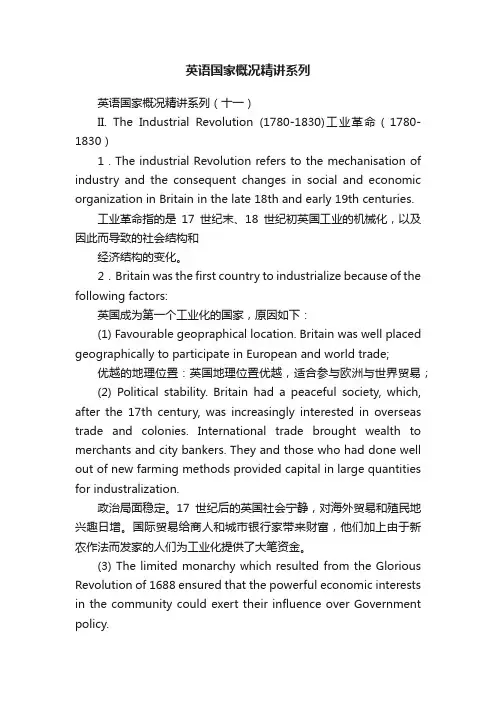
英语国家概况精讲系列英语国家概况精讲系列(十一)II. The Industrial Revolution (1780-1830)工业革命(1780-1830)1.The industrial Revolution refers to the mechanisation of industry and the consequent changes in social and economic organization in Britain in the late 18th and early 19th centuries.工业革命指的是17世纪末、18世纪初英国工业的机械化,以及因此而导致的社会结构和经济结构的变化。
2.Britain was the first country to industrialize because of the following factors:英国成为第一个工业化的国家,原因如下:(1) Favourable geopraphical location. Britain was well placed geographically to participate in European and world trade;优越的地理位置:英国地理位置优越,适合参与欧洲与世界贸易;(2) Political stability. Britain had a peaceful society, which, after the 17th century, was increasingly interested in overseas trade and colonies. International trade brought wealth to merchants and city bankers. They and those who had done well out of new farming methods provided capital in large quantities for industralization.政治局面稳定。
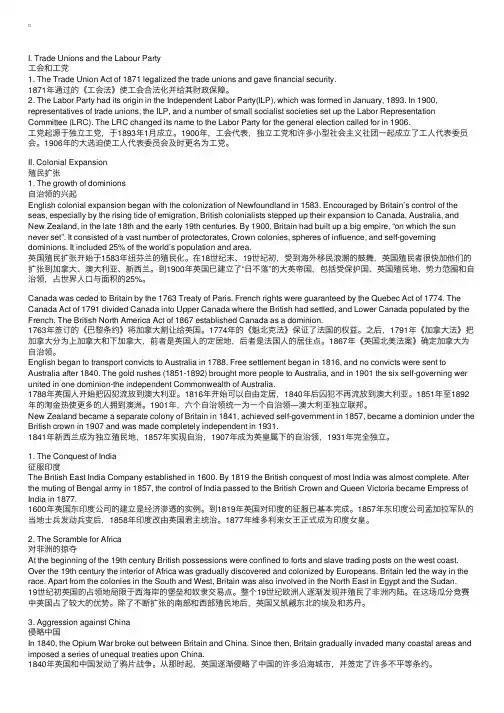
I. Trade Unions and the Labour Party⼯会和⼯党1. The Trade Union Act of 1871 legalized the trade unions and gave financial security.1871年通过的《⼯会法》使⼯会合法化并给其财政保障。
2. The Labor Party had its origin in the Independent Labor Party(ILP), which was formed in January, 1893. In 1900, representatives of trade unions, the ILP, and a number of small socialist societies set up the Labor Representation Committee (LRC). The LRC changed its name to the Labor Party for the general election called for in 1906.⼯党起源于独⽴⼯党,于1893年1⽉成⽴。
1900年,⼯会代表,独⽴⼯党和许多⼩型社会主义社团⼀起成⽴了⼯⼈代表委员会。
1906年的⼤选迫使⼯⼈代表委员会及时更名为⼯党。
II. Colonial Expansion殖民扩张1. The growth of dominions⾃治领的兴起English colonial expansion began with the colonization of Newfoundland in 1583. Encouraged by Britain’s control of the seas, especially by the rising tide of emigration, British colonialists stepped up their expansion to Canada, Australia, and New Zealand, in the late 18th and the early 19th centuries. By 1900, Britain had built up a big empire, “on which the sun never set”. It consisted of a vast number of protectorates, Crown colonies, spheres of influence, and self-governing dominions. It included 25% of the world’s population and area.英国殖民扩张开始于1583年纽芬兰的殖民化。
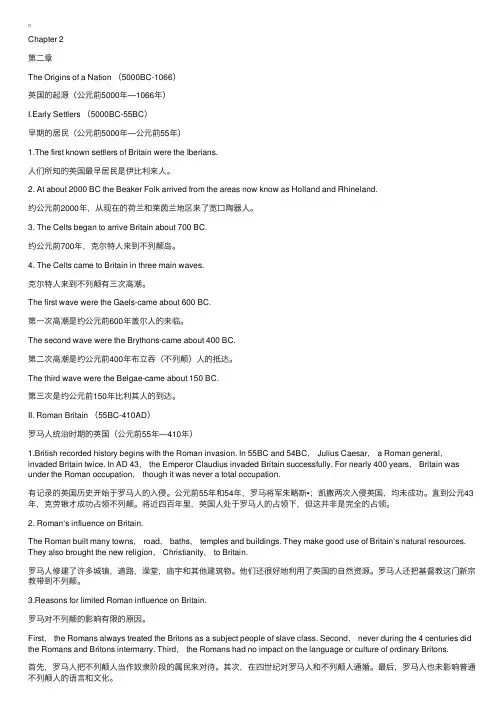
Chapter 2第⼆章The Origins of a Nation (5000BC-1066)英国的起源(公元前5000年—1066年)I.Early Settlers (5000BC-55BC)早期的居民(公元前5000年—公元前55年)1.The first known settlers of Britain were the Iberians.⼈们所知的英国最早居民是伊⽐利来⼈。
2. At about 2000 BC the Beaker Folk arrived from the areas now know as Holland and Rhineland.约公元前2000年,从现在的荷兰和莱茵兰地区来了宽⼝陶器⼈。
3. The Celts began to arrive Britain about 700 BC.约公元前700年,克尔特⼈来到不列颠岛。
4. The Celts came to Britain in three main waves.克尔特⼈来到不列颠有三次⾼潮。
The first wave were the Gaels-came about 600 BC.第⼀次⾼潮是约公元前600年盖尔⼈的来临。
The second wave were the Brythons-came about 400 BC.第⼆次⾼潮是约公元前400年布⽴吞(不列颠)⼈的抵达。
The third wave were the Belgae-came about 150 BC.第三次是约公元前150年⽐利其⼈的到达。
II. Roman Britain (55BC-410AD)罗马⼈统治时期的英国(公元前55年—410年)1.British recorded history begins with the Roman invasion. In 55BC and 54BC, Julius Caesar, a Roman general,invaded Britain twice. In AD 43, the Emperor Claudius invaded Britain successfully. For nearly 400 years, Britain was under the Roman occupation, though it was never a total occupation.有记录的英国历史开始于罗马⼈的⼊侵。
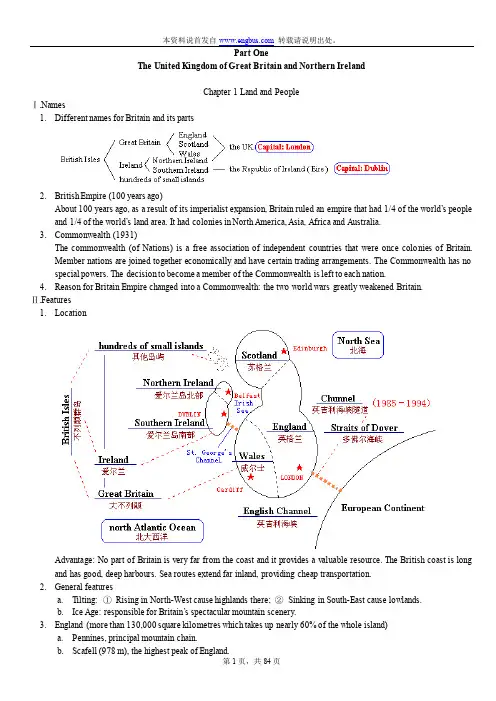
Part OneThe United Kingdom of Great Britain and Northern IrelandChapter 1 Land and PeopleⅠ.Names1.Different names for Britain and its parts2.British Empire (100 years ago)About 100 years ago, as a result of its imperialist expansion, Britain ruled an empire that had 1/4 of the world’s people and 1/4 of the world’s land area. It had colonies in North America, Asia, Africa and Australia.monwealth (1931)The commonwealth (of Nations) is a free association of independent countries that were once colo nies of Britain.Member nations are joined together economically and have certain trading arrangements. The Commonwealth has no special powers. The decision to become a member of the Commonwealth is left to each nation.4.Reason for Britain Empire changed into a Commonwealth: the two world wars greatly weakened Britain.Ⅱ.Features1.LocationAdvantage: No part of Britain is very far from the coast and it provides a valuable resource. The British coast is long and has good, deep harbours. Sea routes extend far inland, providing cheap transportation.2.General featuresa.T ilting: ①Rising in North-West cause highlands there; ②Sinking in South-East cause lowlands.b.Ice Age: responsible for Britain’s spectacular mountain scenery.3.England (more than 130,000 square kilometres which takes up nearly 60% of the whole island)a.Pennines, principal mountain chain.b.Scafell (978 m), the highest peak of England.c.Capital: London.4.Scotland (78,760 square kilometres)a.Three zone:①Highlands in the north: plateau;②Central Lowlands: most important area in Scotland which contain most of the industry and population;③Southern Uplands: moorland.b.Ben Nevis (1,343 m), the highest mountain in Britain.c.Capital: Edinburgh.5.Wales (20,761 square kilometres which takes up less than 9% of the whole island)a.Most of Wales is Mountainous;b.12% of the land is arable;c.Massif 断层;d.Snowdonia (1,085 m), highest mountain in Wales;e.Capital: Cardiff.6.Northern Ireland (14,147 square kilometres which takes up 1/5 of Ireland)a.It has a rocky and wild northern coastline;b.Capital: Belfast.Ⅲ.Rivers and Lakes1.Riversa.Importance:①Great ports (through river) to sea;②Rivers to both European Continent and fishing grounds;③Rivers (carry raw materials) to inland.b.Rivers:①Severn River (338 km): longest river;②Thames River (336 km): second largest and most important (water transportation, Oxford site);③River Clyde: most important river in Scotland.kesa.Lough Neagh: largest lake in Britain (located in Northern Ireland).ke District:①One of the popular tourist attractions in Britain;②15 lakes, the largest ones are Windermere, Ullswater, Derwentwater and Coniston Water;③The home of the lake poets of 19th century: Wordsworth, Coleridge and Southey.Ⅳ.Climate1.Maritimea.Favorable one, winters are mild not too cold and summers are cool not too hot;b.Steady reliable rainfall throughout the whole year;c.Small range of temperature.2.Factorsa.The surrounding waters tend to balance the seasonal differences by heating up the land in winter and cooling it offin summer;b.The Westerlies blow over the country all the year round bringing warm and wet air in winter and keeping thetemperatures moderate;c.The North Atlantic Drift, which is a warm current, passes the western coast of the British Isles and warms them.3.Rainfalla.General: Britain has a steady reliable rainfall throughout the whole year. The average annual rainfall in Britain isover 1,000 mm;b.Character: ①Water surplus in north and west; ②Water deficit in south and east.c.Reservoirs have to be built in highland areas such as Central Wales, the Lake District and the Scottish Highlands.4.Natural calamitiesa.In 1952 the sulphur dioxide in the four-day London smog, an unhealthy atmosphere formed by mixing smoke anddirt with fog, left 4,000 people dead or dying. So most cities in Britain have introduce “Clean air zones” whereby factories and households are only allow to burn smokeless fuel.b.Many areas are subjected to severe gales, which cause flooding, shipwrecks and loss of life, especially in winter. Ⅴ.People (Britain has a population of 57,411,000 in 1990)1.General features:a.Densely populated with an average of 237 people per square kilometer;b.Unevenly distributed: 90% in urban, 10% in rural;c.Concentration: most in England (most in London and south-eastern England);position: English 81.5%, Scottish 9.6%, Welsh 1.9%, Irish 2.4%, Northern Irish 1.8%, Immigrants 2.8%.2.Englisha.Origin: Anglo-Saxons.nguage: ①Southern: BBC (except Cockney); ②Northern: broader.c.Cockney: A Cockney is a Londoner who is born within the sound of Bow Bells – the bells of the church of StMary-Le-Bow Bells in east London.d.It was from the union of Norman conquerors and the defeated Anglo-Saxons that the English people and theEnglish language were born.3.Welsha.Origin: Celts.nguage:①Welsh, an ancient Celtic language: 1% people only speak Welsh, it was given equality with English for allofficial use in Wales in 1965, names beginning with “Ll”;②English.c.Character: emotional, cheerful.d.Culture: Eisteddfodau (威尔斯诗人音乐家大会) / National Eisteddfod, with an purpose to keep the welshlanguage and culture alive.4.Scotsa.Origin: Celts.b.Scots are proud that the English never conquered them.nguage:①Gaelic, old Celtic language of the Scots: it is still heard in the Highlands and the Western Isles and theirnames beginning with M’, Mac, Mc, which means “son of” in Gaelic;②English;d.Character: ①said to be serious, cautious, thrifty; ②in fact they are hospitable, generous, friendly.5.Irisha.Origin: Scots and English Protestants.b.Problem: there has been bitter fighting between the Protestants who are dominant group, and the RomanCatholics, who are seeking more social, political and economic opportunities.nguage(爱尔兰共和国):①Irish or Erse, a form of Gaelic: official first language of the Republic of Ireland;②English: second.d.Character: charm, vivacity, beauty girls.6.Immigrantsa.Origin: West Indies, India and Pakistan.b.Discrimination: Usually the colored immigrants have to take the lowest paid jobs, and when there isunemployment they are usually the first to be sacked.Chapter 2 The Origins of a Nation(5000 BC -1066)Ⅰ.Settlers (5000 BC –55 BC)1.Iberians (the first known settlers)①At about 3000 BC, these short, dark and long-headed people came to Britain, probably from the Iberian Peninsula,now Spain.②Long barrows in Wiltshire and Dorset were their communal burial mounds.③Stonehenge in Wiltshire is more dramatic monuments, which may have religious and political means.2.Beaker Folk①At about 2000 BC they come from the areas now known as Holland and the Rhineland.②They took the name from their bell-shaped drinking vessels with which they were buried in crouching positions inindividual graves.③They built hill forts, with the finest examples of Maiden Castle.3.Celts①A taller and fairer race began to arrive about 700 BC.②They may originally come from eastern and central Europe, now France, Belgium and southern Germany.③They came in three main waves: a. Gaels at 600 BC (Gaelic); b. Brythons at 400 BC; c. Belgae at 150 BC(industrious and vigorous).④The Celtic bribes are ancestors of Highland Scots, the Irish and the Welsh, and their languages are the basis of bothWelsh and Gaelic.⑤The Celts’ religion was Druidism (human sacrifices). The Druids were the wise men, astrologers and soothsayers.Ⅱ.Roman Britain (55BC-410AD)1.Roman ConquestBritish recorded history begins with the Roman invasion. Julius Caesar, invaded Britain for the first time in 55BC. He returned the following year, but he didn’t succeed. The successful invasion was take place in AD43, headed by the Emperor Claudius.2.Reasons for untotal occupation: a. some parts of the country resist; b. Roman troops were often withdraw from Britainto fight in other parts of Roman Empire.3.Ways to keep Picts: They built two great walls to keep the Picts, so called because of their “painted faces”, out of thearea they had conquered. These were Hadrian’s Wall and Antonine Wall.4.Three problemsa.Picts still attacked them periodically;b.Saxon pirates attacked them in the southeast;c.Control was only effective in the south-eastern part of the country.5.Achievementwork of towns and roads.①Caster and Chester means camp.②Capital: London (Londinium).③T wo cities: Y ork had been created as a northern stronghold; Bath rapidly developed because of its waters.b.Make use of Britain’s natural resources, mining lead, iron and tin and manufacturing pottery.6.Religion: Christianity.7.Reasons for withdraw in AD 410: a. barbarians from Eastern Europe at the gates of Rome; b. repeated attacks fromPicts and Scots; c. needing to set up a new military front on the east coast to hold off the Germanic Saxon tribes invading from Europe.8.Why was the Roman influence on Britain so limited?The Romans always treated the Britons as a subject people of slave class. Never during the 4 centuries did the Romans and Britons intermarry. The Romans had no impact on the language or culture of ordinary Britons.Ⅲ.Anglo-Saxons (446-871)1.Anglo-Saxons and the found of HeptarchyThe Anglo-Saxons were three tribes of the Germanic people who originally lived in the northwest of modern Germany.In the mid-5th century a new wave of invaders, Jutes, Saxons, and Angles came to Britain. They were three T eutonic tribes. The leader of Jutes, Hengist, became the King of Kent in 449. Then the Saxons established their kingdoms in Essex, Sussex and Wessex from the end of 5th century to the beginning of the 6th century. The Angles settled in East Anglia, Mercia and Northumbria. These seven principal kingdoms of Kent, Essex, Sussex, Wessex, East Anglia, Mercia and Northumbria have been given the name of Heptarchy.2.Wars among Heptarchya.Offa, King of Mercia, built the great earthwork known as Offa’s Dyke, control for a long time virtually all central,eastern and south-eastern England.b.In 829, Egbert, King of Wessex, became an overlord of all the English.3.Religiona.T eutonic religion (The names T uesday, Wednesday, Thursday and Friday derive from their gods)b.Christianity①Columba, 563, convert north commoner.②In 597, Pope GregoryⅠsent St. Augustine, the Prior of St. Andrew’s Monastery in Rome, to England toconvert the heathen English to Christianity. In 597, St. Augustine became the first Archbishop of Canterbury.Augustine was remarkably successful in converting the king and the nobility, but the conversion of thecommon people was largely due to the missionary activities of the monks in the north.c.Disagreement: The Roman missionaries held that the Pope’s authority was supreme, and the Celtic missionariesheld that Christian belief did not require a final earthly arbiter. They held a conference at Whitby in 664. Finally,the Roman missionaries gained the upper hand.4.AchievementsThe Anglo-Saxons laid the foundations of the English state. They divided the country into shires. They devised the narrow-strip, three-field farming system. They also established the manorial system. And they created the Witan.5.QuestionsⅣ.V iking and Danish1.The Norwegian V ikings and the Danes from Denmark attacked various parts of England from the end of the 8th century.They became a serious problem in the 9th century, especially between 835 and 878. The V ikings and the Danes were posing a threat to the Saxon kingdom.2.Alfred, king of Wessex was strong enough to defeat the Danes and came to a relatively friendly agreement with themin 879.a.Danes gained control of north and east of England, i.e. “the Danelaw”.b.Alfred, king of Wessex, rule the rest.3.Alfred’s achievements.Alfred, king of Wessex, is known as “the father of the British navy” as he founded a str ong fleet which first beat the Danes at sea, then protected the coasts and encouraged trade. He also reorganized the fyrd (the Saxon army), making it more efficient. Alfred, who is said to have taught himself Latin at the age of 40, translated into English Bede’s Ecclesiastical history of the English People. A learned man himself, he encouraged learning in others, established schools and formulated a legal system. This, as well as his admirable work with the army and the navy, makes him worthy of his title “Alfred the Great”.4.Successors.a.King Ethelred the Unready tried paying the invaders, who renewed invasions because the successors reconqueredthe Danelaw, to stay away by imposing a tax, called the danegeld, on his people.b.Canute, the Danish leader, was chosen by Witan as king. He made England part of Scandinavian empire whichincluded Norway as well as Denmark.Ⅴ.The Norman Conquest (1066)1.Background: King is also said to have promised the English throne to William, Duke of Normandy. But, when Edwardwas on his deathbed, four men laid claim to the English throne. Finally, the Witan chose Harold as king. Four men: King of Norway / T ostig Ⅼ→Harold (king) →Duke of Normandy( join together ) ( fight ) ( fight )2.Process: ①1066.10.14, the battle on Senlac Field (near Hastings), where Harold was killed; ②1066 Christmas,William crowned King of England by the Archbishop of Y ork.3.Measure to face Saxon risings in the north: “harrying of the north”.4.Significance: The Norman Conquest of 1066 is perhaps the best-known event in English history. William theConqueror confiscated almost all the land and gave it to his Norman followers. He replaced the weak Saxon rule witha strong Norman government. So the feudal system was completely established in England. Relations with theContinent were opened, and civilization and commerce were extended. Norman-French culture, language, manners, and architecture were introduced. The Church was brought into closer connection with Rome, and the church courts were separated from the civil courts.Chapter 3 The Shaping of the Nation(1066-1381)Ⅰ.An outline of this period:1.Norman House: WilliamⅠ2.Plantagenet House: HenryⅡ①Parliament; ②100 years war; ③Uprising 1381; ④Roses (House of Lancaster – House of Y ork)3.T udor House (200): ①Civil war; ②HenryⅧ; ③ElizabethⅠ; ④Renaissance.4.Stuart House: ①JamesⅠ; ②CharlesⅠ; ③Civil war.mon wealth: Cromwell.6.Restoration: 1688 Glorious Revolution.7.Rise and fall of the Empire: Commonwealth.Ⅱ.Norman Rule (1066-1381)1.William’s Rule (1066-1087)①Feudal system in England was completely established. According to this system, the King owned all the landpersonally. William gave his barons large estates in England in return for military service and a produce. The barons parceled out land to the lesser nobles, knights and freemen, also in return for goods and ser vices. At the bottom were the villains or serfs, unfree peasants.②Feature: All landowners took the oath of allegiance for the land they held, not only to their immediate lord, butalso to the king.③William replaced the Witan with the Grand Council of his new tenants-in-chief.④Domesday Book (1086): It was the result of a general survey of England made in 1085, and stated the extent,value, the population, state of cultivation, and ownership of the land.a.1/2 the cultivated land in the country was in the hands of 170 tenants-in-chief;b.1/5 was held personally by the King;c.most of the rest by bishops and abbots and other heads of religious houses.⑤His policy towards the church was to keep it completely under his control, but at the same time to uphold itspower.⑥In the reign of the Norman kings the Norman culture flowered on the English soil.2.Success: three sons①Robert gain Normandy;②William Rufus (WilliamⅡ) gain England; (Killed)③Henry gains a large sum of money. After WilliamⅡ’s death, he gain England’s cr own. Henry has no son, so KingStephen took the crown with the compromise of receive Henry, son of Henry’s daughter, as joint ruler. After King Stephen’s death, Henry became king HenryⅡ.Ⅲ.House of Plantagenet1.HenryⅡ’s reformA.Measures to end the disorders: He forced the Flemish mercenaries to leave England; recalled grants of Royal lands;demolished castles; strengthened the powers of his sheriffs and relied for militia.B.Administrative: a. abolished the annual land tax based on hide, and emerged a new tax which assessed at thepercentage of a subject’s annual rents and chatells; b. revival and elaboration of HenryⅠ’s policies.C.Legal reform: HenryⅡgreatly strengthened the king’s Court and extended its judicial work. He divided thecountry into six circuits and appointed itinerant justices. The common law and jury system came out. He wishing to reform certain abuses in Church government, instead that all clerks charged with criminal offences should be tried in the king’s courts.mon law: It is the unwritten law common to the whole people and is “case-made”, i.e., based on precedentjudgments, and derived from acknowledged custom.2.Conflict between king and Becket.A.Reason: It was these exceptional privileges and benefit of clergy that brought King Henry into collision withThomas Becket.B.Process:a.In 1154, Thomas Becket was appointed Chancellor of England.b.In 1162, Henry made Becket Archbishop of Canterbury.c.The different view of a murder charge of a clerk man brought matters to a crisis.d.In 1164, the Great Council of HenryⅡdrew up the Constitutions of Clarendon to increase the jurisdiction ofthe civil courts at the expense of the church courts.e.Becket rejected them after a reluctantly signed, which angry HenryⅡ. So he spend 6 years on the Continent.f.In 1170, Becket returned to England. Fresh quarrels broke out.g.In 1170, four knights of the royal household took litera lly the King’s wish and murdered Becket.C.Result: a. grave became a place of pilgrimage; b. Chaucer, The Canterbury Tales (which describes a group ofpilgrims traveling to Canterbury to visit Thomas Becket’s tomb); c. T.S. Eliot, Murder in the Cathedral.Ⅳ.Great Charter1.Background: Three crusades and wars against France drain upon financial resources of England, and baronscomplained that the king had failed to protect the Norman lands from the advances of the French King and he had imposed high taxes.2.Demand contents: Magna Carta (1215); Magna Carta had altogether 63 clauses, of which the most important matterswere these: no tax should be made freely; no freeman should be arrested except by the law of the land; the Church should possess all its rights; London and other towns should retain their ancient rights and privileges.3.Result: A committee of 24 barons plus the Mayor of London was chosen to help the king carry out the Charter, withthe right of declaring war on him should he break its provisions.4.Significant: Magna Carta has long been popularly regarded as the foundation of English liberties, it was a statement ofthe relationship between the Crown and the barons. The spirit of Magna Carta was the limitation the powers of the king.Ⅴ.Parliament1.HenryⅢ: ①an expensive war with France which ended with the loss of the whole of Poitou; ②demands formoney to enable his son to be crowned King of Sicily which brought the matters with parliament to a head.2.Barons, under Simon de Montfort forced the king to swear to accept the Provisions of Oxford: ①Henry shouldappoint a new Grand Council of twenty-four members, half of whom were to be nominated by the barons themselves;②the King should have a permanent body of fifteen nobles and bishops to advise him, without whose authority theking could not act.3.Civil war between HenryⅢand barons come to the first Parliament in 1265.Henry refused to confirm to the Provisions of Oxford put forward by barons. A civil war broke out between the king’s supporters and the baronial army. In 1264, the king was defeated. Simon de Montfort summoned in 1265 the Great Council to meet at Westminster, together with two knights from each county and two burgesses from each town, a meeting which has been seen as that of the earliest parliament.The origin of Parliament is Witan, with the development of Grand Council. Grand Council later developed into the Lords (baron and bishop) and the Commons (knight and citizen, can present petitions), which known as a parliament.4.1284 the Statute of Wales.The Statute of Wales in 1284 placed the country under English law and EdwardⅠpresented his new-born son to the Welsh people as Prince of Wales, a title held by the heir to the throne ever since.Ⅵ.100 year’s war1.Reason: The causes were partly territorial and partly economic. The territorial causes were the large duchy ofAquitaine. The economic causes were connected with Flanders. England’s desire to stop France from giving aid to the Scots and a growing sense of national consciousness. The French refused to recognize EdwardⅢ’s claim of French Crown.2.Process: ①At first English (EdwardⅢ) were successful; ②After a long peaceful lull, French (HenryⅤ) wonvictory; ③After French King’s death, Joan of Arc drove the English out of France.3.Significance: The expulsion of the English from France is regarded as a blessing for both countries; had they remained,the superior size and wealth of France would certainly have hindered the development of a separate English national identity, while French national identity was hindered so long as a foreign power occupied so much French territory. Ⅶ.Black death 1348-13491.Definition: Black Death was the modern name given to the deadly bubonic plague, an epidemic disease spread by ratfleas. It spread through Europe in the 14th century, particularly in 1347-50.2.Result: It killed between 1/2 and 1/3 of the population of England. As a result, much land was left untended and therewas a terrible shortage of labor.Ⅷ.Uprising1.Reason: ①unfair treatment by government and land owner (Two Statute: In 1351 the government issued a Statute ofLabourers which made it a crime for peasants to ask for more wages; A later statute proposed that any labourer who left his place of work to seek higher wages should be branded with the letter F on his forehead as a sign of falsehood.);②imposition of a series of taxes known as poll taxes, which caused deep and widespread discontent; ③the Lollards(They refer to Poor priests and itinerant preachers who were John Wyclif’s followers. They went about preaching to the equality of men before God. They served as mental encouragement and stimulation and play an important role in the Peasant Uprising of 1381.).2.Processes: ①In 1381, army led by Wat Tyler and Jack Straw occupied London; ②They present the demands(abolition of villeinage, reduction of rent, free access to all fairs and markets, general pardon) which were granted by king; ③Finally, they were suppressed.3.Significance: The rebellion was a truly social one, directed against the rich clergy and the lawyers as well as againstthe landowners. The uprising dealt a telling blow to villeinage, and a whole new class of yeomen farmers emerged,paving the way for the development of capitalism.Chapter 4 T ransition to the Modern Age(1455-1688)Ⅰ.T ransition1.Wars of the Roses (1455-1485)①Reason: After the Hundred Y ears’ War, nob les had to seek a new outlet for their ambition by an attempt todominate the government at home.②Definition: It referring to these battles between the great House of Lancaster, symbolized by the red rose, and thatof Y ork, symbolized by the white.③Process: (three stages)④Significant: From these wars feudalism received its deathblow. The great medieval nobility was much weakenedand discredited. The king’s power now became supreme. But the interests of the majority of the common people were not deeply engaged.2.HenryⅦ①Domestic: a. refill treasury; b. control noble’s power.②Foreign: a. prevent foreign powers to disrupt the country; b. neutralize to all threats.③All above bring HenryⅦboth peace and prestige.Ⅱ.Reformation1.HenryⅧ(6 wives)①Measure:A. Domestic: a. control over border areas; b. gentry control local government (Justices of Peace).B. Foreign: a. aided by Archbishop and Lord Chancellor; b. 1517 peace conference in London; c. ally withsuperpower.②Reformation:a.Reasons: There were 3 main causes: a desire for change and reform in the Church had been growing for manyyears and now, encouraged by the success of Martin Luther, many people believed its time had come; the privilege and wealth of the clergy were also resented; and Henry needed money.b.Direct cause: HenryⅧwanted to divorce Catherine of Aragon because she could not produce a male heir forhim.c.Purpose: Henry’s reform was to get rid of the English Church’s connection with the Pope, and to make anindependent Church of England. (He made his break with Rome g radually. He dissolved all of England’smonasteries and nunneries.)d.T wo acts: a. 1534 Act of Succession; b. 1535 Act of Supremacy.e.Three important effects: they stressed the power of the monarch; Parliament had never done such important; hisattack on the Pope’s power encouraged many critics of the abuses of the Catholic Church, and he became Supreme Head of the Church of England in 1535.f.Note: Real religious change came in HenryⅧ’s son Edward’s time. People call his switch to Protestant theology“The Reformation”.2.Mary T udor①She attempt to forcibly reconvert England to Roman Catholicism.②She is called “Bloody Mary” for at least 300 Protestants were burnt as heretics.③The monarch who lost the French port of Calais during a renewed war with France.④Protestantism and nationalism were now forever synonymous.3.ElizabethⅠ: England has been Protestant ever since.Ⅲ.ElizabethⅠ1.Elizabeth and Parliament①Work with Parliament (the Puritans in the House of Commons demanded further religious reform, but they stillloyal to Queen).②Turbulent for Parliament’s ask: a. right of free speech; b. discussion at will; c. five personal questions (religion,marriage, foreign policy, the succession to the throne, and finance).2.Elizabeth and religion①Elizabeth’s religious reform was a compromise of views. She broke Mary’s ties with Rome and restored herfather’s independent Church of England. (keep to Catholic doctrines; free from the Papal contr ol)②Conflict: a. Elizabeth – Protestant; b. Mary – Catholic.3.Elizabeth’s foreign policy①France: friendly.②Spain:A.1588 PhilipⅡ: a. want to bring England back to Catholicism; b. stop England’s aid to the Netherlands whereProtestant rebels were in revolt against their Spanish masters.B.Destruction of Spanish Armada: a. showed England’s superiority as a naval power; b. stop the attempt ofCatholicism to recover the northern countries of Europe; c. enabled England to become a great trading andcolonizing nation.Ⅳ.JamesⅠ1.Controversy: a. Puritan ask for further Reformation; b. James declared “No Bishop, No King”.2.Catholic’s plots.①Cobham’s Plot: Sir Walter was sent to the T ower of London for 13 years. In 1615, JamesⅠrelease him for theneed of money. With 13 ships, he went to Guiana for gold mine, but failed and was executed finally.②Gunpowder Plot: On November 5, 1605, a few fanatical Catholics attempted to blow King James and his ministersup in the Houses of Parliament where Guy Fawkes had planted barrels of gunpowder in the cellars. The immediate result was the execution of Fawkes and severe anti-Catholic laws. (celebration)3.Puritan’s protest①Concession: King James’s Bible, Authorized V ersion 1611.②Flee:A.Many Puritans had left England for Holland.B.In 1620, 201 Pilgrim Fathers sailed from New Plymouth in the Mayflower, and founded New Plymouth inAmerica, Britain’s first settlement in the New World.4.James (a firm believer in the Divine Right of Kings) and Parliament: ①none for 7 years; ②1621 recall Parliament;。
英语国家社会与文化入门(上)Unit 1 A Brief Introduction to the United Kingdom IThe full name of the country of UK is the Untied Kingdom of Great Britain and Northern Ireland.UK includes 4 parts: the island of Great Britain is made up of England, Scotland and Wales, and Northern Ireland.Different people who belong to different class will tend to read different newspaper, watch different television programmes, speak with a different accent, do different things in their free-time, and have different expectations for their children.Before the 1st century AD Britain was made up of many tribal kingdoms of Celtic people.In 43 AD Britain was invaded by the Roman Empire and England and Wales became a part of the Roman Empire for nearly 400 years.After Roman time, Britain was under threat from outside, this time from Germanic peoples: the Angles, and the Saxon.In the 5th century AD it is said that a great leader appeared, united the British, and with his magical sword, Excalibur, drove the Saxons back. This is the story of King Arthur. According to legend Arthur gathered a company of knights to him and conflict between his knights led to Arthur creating the famous ―round table‖at which all would have equal precedence.Anglo-Saxon invaders were the forefathers of the English, the founders of ―Angle-land‖ or ―England‖ as it has become know.From the late 8th century on raiders from Scandinavia, the ferocious Vikings, threatened Britain‘s shores.The next invaders were the Normans, from northern France, who were descendants of Vikings.Under William of Normandy they crossed the English Channel in 1066.William took the English throne, and became William the First of England.Robin Hood was a Saxon nobleman oppressed by the Normans, who became an outlaw, and with his band of ―merry men‖ hid in the forest of Sherwood in the north midlands of England and they went out to rob from the rich to give to the poor.Charles the First‘attempt to overrule parliament in the 1640s led to a civil war in which parliamentary forces were victorious, and the king was executed. And then England was ruled by parliament‘s leader, Oliver Cromwell.The largest city of Scotland is Glasgow and the capital city is Edinburgh.Scotland was not conquered either by the Romans or the Anglo-Saxons.Like England Scotland began to experience Viking raid in the 9th century.Under the leadership of Robert the Bruce, the Scots were victorious at the Battle of Bannockburn, leading to 300 years of full independence.In 1603, Queen Elizabeth the First of England died childless, and the next in line to the throne was James the Sixth of Scotland, so he also became James the First of England, uniting the two thrones.In 1707 by agreement of English and Scottish parliaments, Scotland joined the Union.The Scotland Act 1998 provided for the establishment of the Scottish Parliament and Executive.Scottish writes have given the world such well-known work as Walter Scott‘s romances of highland Scotland and ―Auld Lang Syne‖ (by Robert Burns)The capital city of Wales is Cardiff.Unit 2 A Brief Introduction to the United Kingdom IIThe capital city of Northern Ireland is Belfast.The most famous landmark of Northern Ireland is the ―Giant‘s causeway‖, a rocky promontory made up of black hexagonal columns.From the time of Queen Elizabeth I the new settlers, loyal to the British crown and Protestant in religious persuasion, were granted land, position, and privileges which had been systematically take away from the indigenous, Roman Catholic population.―Great hatred, little room‖ was the way the modern poet W. B. Yeats described the situation. Until 1921 the full name of the UK was ―The United Kingdom of Great Britain and Ireland‖, not only ―Northern Ireland‖, because the whole island of Ireland was politically integrated with Great Britain.The Easter Rising of 1916 was the most spectacular event, in which the rebels took over Dublin‘s Post Office, forcing the British to retake it by military means.In 1919 a group calling itself the IRA (Irish Republican Army) expanded the fighting.In the end the conflict became too great to ignore, and as the Sinn Fein party, who were supporters of the Irish terrorists, gained most of the Irish seats in the British parliament, Irish independence became inevitable.In 1921 the southern 26 counties formed an independent ―free state‖, while the 6 north-eastern counties remained a part the UK.In 1969, the first British soldiers were seen on Northern Irish streets.The official IRA thought enough progress had been made that they could concentrate on a political process, and run candidates for elections, but a strong faction felt that armed force was the only way to get the British out, and separated from the officials, calling themselves the ―Provisional IRA‖.In 1971 the Northern Irish government took the desperate step of imprisoning terrorist suspects from both sides without trial, a policy known as ―internment‖, which targeted primarily Catholic men in the North.In 1972 468 people were killed in Northern Ireland and that day has now been mythologiesed as ―Bloody Sunday‖, an important symbol of British oppression.In 1973, an agreement was reached between the main political parties in Northern Ireland, and importantly, the British and Irish governments, which led to a new form for the Northern Irish Parliament, with a Power-Sharing mechanism.The Sinn Fein party spoke of a twin campaign for union with Ireland, both political and military, which they called the policy of ―The Bullet and the Ballot Box‖.As a result of multi-party negotiations, aided this time by the intervention of the United States Senator George Mitchell, the Good Friday Agreement known also the Belfast Agreement, emerged on 10 April 1998.Unit 3 The Government of the United KingdomBritain is arguably the oldest representative democracy in the world, with roots that can be traced over a thousand years.The oldest institution of government is the Monarchy.The power of the monarchy was largely derived from the ancient doctrine of the ―divine right of kings‖The opposition was so powerful the king finally granted a gang of feudal barons and the Church a charter of liberty and political rights, still know by its medieval Latin name of Magna Carta, which is still regarded as Britain‘s key expression of the rights of citizens against the Crown.The civil war which brought the Roundheads to power in the 17th century was rooted in a dispute over the power of the king vis-à-vis Parliament.In 1689 Parliament passed the Bill of Rights which ensured that the King would never be able to ignore Parliament.In 1832, when a system for choosing the House of Commons by popular election replaced the monarch‘s job of appointing representatives, the modern political system was born.The party with the most supporters in the Commons forms the government, and by tradition, the leader of that party becomes Prime Minister.Britain is both a parliamentary democracy and a constitutional monarchy.British governance today is based upon the terms and conditions of the constitution.Israel and Britain are the only two countries without written constitutions of the sort which most countries have.The foundations of the British state are laid out in statute law, that is, laws passed by Parliament; the common laws, which are laws which have been established through common practice in the courts, not because Parliament has written them; and conventions, which are rules and practices which do not exist legally, but are nevertheless regarded as vital to the workings of government.Parliament is supreme in the British state because it alone has the power to change the terms of the Constitution.Strictly speaking, the Parliament today consists of the Queen, the House of Lords and the House of Commons.The role of the monarchy today is primarily to symbolize the tradition and unity of the British state.There are 724 Lords and 646 Members of Parliament in the House of Commons.Unit 4 Politics, Class and RaceIn 1928 it reached the current level of about 99% can vote (those excluded are Lords, certain categories of convicted criminals, the legally insane, and resident foreign citizens –except UK resident citizens of the Irish Republic)After a government has been in power for 5 years it has to resign and hold a ―general election‖, in which all British adults are given the chance to vote again for their constituency‘s MP.Anyone who is eligible to vote can stand as an MP. It is necessary only to make a deposit of 500 pounds which is lost if the candidate does not receive at least 5% of the vote.There are three major national parties: The Conservative party and the Labour party are the two biggest, and any general election is really about which of those two is going to govern. But there is a third important party, the Liberal Democrats.The Labour party is the newest of these three, created by the growing trade union movementat the end of the nineteenth century.The Conservative party is the party that spend most time in power.The Liberal Democrats are the third biggest party, and to some extent may be seen as a party of the ―middle‖, occupying the ideological ground between the two main parties.Margaret Thatcher is the UK‘s first woman Prime Minister.The car-worker probably reads a paper like The Sun: a newspaper with little heard news and more about TV soap operas, the Royal family, and sport. The university teacher might read The Guardian: a larger newspaper with longer stories, covering national and international news, ―high‖ culture such as theatre and literature, and so on.Unit 5 The UK EconomyThe UK is now the world‘s sixth largest economy.The UK is not only a member of the G7, G8, G20 major economies, but also a member of the World Trade Organization.Firstly, the country had gone heavily into debt in order to finance the war, selling many of its accumulated overseas assets, and borrowing large amounts from the United States and Canada.Secondly, the ear of empire was over. India, popularly known as ―The Jewel in the Crown‖ of the British Empire, gained its independence in 1947.Thirdly, despite the relatively rapid and trouble-free process of decolonization, Britain has still forced to maintain a substantial and expensive military presence in many overseas locations until the process was completed.Fourthly, although Britain was quite badly damaged by German bombing during the war, its industry survived comparatively unaffected. This failure to invest sufficiently in industry also reflects a long-standing and continuing problem in the UK economy.National economies can be broken down into three main areas: ―primary‖ industries, such as agriculture, fishing, and mining; ―secondary‖ industries, which manufacture complex goods from those primary products; and tertiary industries, often described as services, such as banking, insurance, tourism, and the selling of goods.Britain‘s agricultural sector is small but efficient, producing 58% of the UK‘s food needs with only 2% of its workforce.Scottish ports land the majority of the fish caught.Three of the biggest ten companies in Britain are to be found in the energy sector: Shell, British Petroleum (BP), and British Gas.The World‘s largest mining company, RTZ, is a UK company which operates mines all over the world.The British company Glaxo-Wellcome is the biggest drug company in the world.70% of the UK‘s workforce are employed in the service sector.London is one of the top three financial centres in the world. It has the greatest concentration of foreign banks in the world, accounts for 20% of all international bank-loans, and is the world‘s largest foreign exchange market. As well as banking, dealing in commodities and insurance are important processes in ―The City‖—the name given to the historic area at the centre of London where all this business is concentrated, at the heart of which is London Stock Exchange, one of the business share-dealing centres in the world.Aerospace is one of the UK‘s highest value adding manufacturing sectors.Unit 6 British LiteratureThe major literature competition is the annual Booker Prize.Much early British writing was concerned with Christianity: Anglo-Saxons produced beautifully illustrated versions of the Bible: the most famous of these is the Book of Kells. One of the oldest of these early ―Old English‖ litrary works is long poem from Anglo-Saxon times called Beowulf.One work from Norman Conquest times often studied today by middle school and college students is The Canterbury Tales by Geoffrey Chaucer, who was the first court poet to write in English.There was a general flowering of cultural and intellectual life in Europe during the 15th and 16th century which is known as ―The Renaissance‖.Christopher Marlowe‘s most famous play is The Tragical History of Doctor Faustus, the story of a man who sold his soul to the devil in return for power.William Shakespeare is probably the best-known literary figure in the world.The tragedies include Romeo and Juliet, Hamlet, Othello, King Lear, and Macbeth.Among the comedies are The Taming of the Shrew, A Midsummer Night‘s Dream, Twelfth Night, and The Tempest.A permanent monument of English literature style commemorates James‘s name. He ordered the translation of the Holy Scriptures known as the King James Bible(1611).The Essays of Frances Bacon made popular in English a literary form widely practiced afterward.The literary giant of the 17th century, John Milton was much bound up in Puritan Revolution. The most famous pamphlets is Areopagitica. During his retirement from public life he produced his masterpieces: Paradise Lost, its sequel, Paradise Regained, and the poetic tragedy Samson Agonistes.Johnthan Swift‘s name is linked with the fanciful account of four voyages known to us as Guliver‘s Travels.Scotland produced a much-loved poet, Robert Burns, who wrote in Scottish dialect.Daniel Defoe ‗s first and greatest novel appeared in 1719, which was Robinson Crusoe, the most famous tale of shipwreck and solitary survival in all literature.Two poets offered what had been called romantic poetry‘s ―Declaration of Independence.‖This was a volume of poems called Lyrical Ballads, written by William Wordsworth and Samuel Taylor Coleridge.George Gordon, Lord Byron‘s large body of work includes the partly autobiographical Childe Harold‘s Pilgrimage. Don Juan owed its title.John Keats‘s art is nowhere greater than in the two pomes ―Ode on a Grecian Urn‖ and ‖Ode to a Nightingale.‖Percy Bysshe Shelley‘s writing has a wide range. The lovely musical quality of his work appears in the fine verses of ―Ode to the West Wind‖ and ―To a Skylark‖The spirit of Romanticism also occurred in the novel, notably in Mary Shelley‘s (the poet Shelly‘s wife) Frankenstein, the story of science gone wrong through the disastrous consequences of an arrogant scientist‘s attempts to create life.Most of Sir Walter Scott‘s themes came from medieval and Scottish history and he wrote a number of romantic novels.Jane Austen, who excelled at this form of writing, is indeed one of the greatest of all Englishnovelists. A delightful, almost flawless stylist, she has devoted admirers of her Sense and Sensibility, Pride and Prejudice, and Emma, among other works.Perhaps the most famous literary family in British history are the Bronte sisters, and they too were influenced by the Romantic movement. Charlotte Bronte‘s Jane Eyre and Emily‘s Wuthering Heights are the most successful.Charles Dickens produced Pickwick Papers, Oliver Twist, David Copperfield and Great Expectations.Later in the 19th century Robert Louis Stevenson also wrote Scottish historical romances, The Adventures in Treasure Island and Kidnapped thrill readers young and old. His most famous short novel was The strange Case of Doctor Jekyll and Mr. Hyde.Among Thomas Hardy‘s better-known novels are The Return of the Native, Tess of the D‘urbervilles, and Jude the Obscure.20th century literature can be broadly divided into two stylistic periods: Modernism, and Postmodernism.One of the most famous of English modernist writers is Joseph Conrad, whose most famous novel is The Heart of Darkness.Virginia Woolf is another writer associated with Modernism, and one of the most famous writers of the century. Mrs. Dalloway, To the Lighthouse, and Orlando are among her best-known books.D.H. Lawrence wrote Sons and Lovers.Unit 7 British Education SystemMany people think school is just about teaching children what are often called ―the three Rs‖–―reading, riting and rithmetic‖. But the purpose of the British education system is also to socialize children.The school (or college) tie is a clear marker of social class.Education in the UK is compulsory. Children are legally obliged to attend school from the age of 5 (4 in Northern Ireland) to 16.State schools are funded by local and central government. The government also sometimes assists schools established by religious groups.In the private sector there are independent schools which are commonly, but confusingly, called public schools. Independent schools receive their funding through the private sector and through tuition rates, with some government assistance.Between the ages of 5 to 11, pupils mainly attend state sector primary schools.From the age of 11 up to around the age of 19, students attend secondary schools.General Certificate of Secondary Education are the main means of assessing pupils‘ progress in their final 2 years of compulsory education.Other pupils who decide not to go to university may choose to take vocational training.So far, the UK has only one privately funded university, the University of Buckingham. Oxford and Cambridge date from the 12th and 13 centuries.The Open University offers a non-traditional route for people to take university level courses and receive a university degree.Unit 8 The British MediaThe observer, which is still published every Sunday, first appeared in 1791, making it theworld‘s oldest Sunday newspaper, while The Times, which began publishing in 1785, is the United Kingdom‘s oldest daily newspaper.This watchdog function, keeping an eye on the government, is one of the reasons why a free press is considered so important to the functioning of parliamentary democracy.The British media all must follow the Advertising Code which ensure that advertisements are legal, decent, honest and truthful; have a sense of responsibility for consumer and society; and respect the principles of fair competition.Until the 1980s, almost all the national newspapers had their headquarters on or around Fleet Street in London, and sometimes you will hear newspaper culture referred to still as ―Fleet Street‖, or even, sometimes, the Street of Shame, reflecting the birth of scandals which take place.While officially speaking the British press is ―free‖ from government control and censorship and can print what it likes, there are limits to what will appear in the daily paper.The oldest and most popular soap, which began in the 1960s, is Coronation Street.The British Broadcasting Corporation –more familiarly known as the BBC or even ―the Beeb‖– us Britain‘s main public service broadcaster.The BBC is funded by license fees and viewers must buy a license each year for their TV set. Unit 9 Sports, Holidays and Festivals in Britain―Football hooligans‖, supporters of rival teams, sometimes clash before, during and after matches and occasionally run riot through the town, breaking windows and beating each other up.Wimbledon, actually a London suburb, is where the world‘s best players gather to compete on grass courts. It is one of the major events of the British sporting calendar and probably the most famous tennis event in the world.Cricket was one of the very first team sports in Britain to have organized rules and to be played according to the same rules nationally.The game of golf was invented by the Scottish.The true sport of British Kings and Queens is not skiing or golfing, but horse racing.There are two kinds of horse racing: flat racing, where horses and riders compete on a flat, oval track; and steeple-chasing, which is racing either across the countryside, or around a course designed to represent the obstacles you might encounter in the countryside. Christmas, December 25th, is the biggest and best loved British holiday.There are three Christmas traditions which are particularly British: one is the Christmas Pantomime, a comical musical play.Another British Christmas tradition is to hear the Queen give her Christmas message to her realm over the television and radio.A third British tradition, which is also celebrated in countries with British heritages, is Boxing Day, which falls on the day after Christmas.For church goers it is Easter, not Christmas, which is the most important Christian festival. One of Britain‘s most impressive and colourful festival happens on the second Saturday in June when the Queen‘s Birthday is officially celebrated by ―Trooping the Colour‖around Buckingham Palace in London.The UK, unlike most countries, does not have a ―national day‖.One truly English holiday is Bonfire Night –sometimes called Guy Fawkes Night –celebrated in the early autumn.The Twelfth is the high point of what is known as the Marching Season, when Protestant ―Orangemen‖ take to the streets wearing their traditional unifors of bowler hats, black suits and orange sashes, marching through the streets sing, banging durms and playing in marching bands.Northern Irish Catholics celebrate the birthday of the patron saint of Ireland, St Patrick, on March 17 each year.How Hogmanay is celebrated varies throughout Scotland, but one widely practiced is ―first footing‖.Each year Scottish people all over the world celebrate their most beloved national poet, Robert Burns, by holding a Burns Supper on the evening of his birthday.Halloween is a Scottish festival that comes from the great feast of the pagan Celts which marked the arrival of the winter half of the year.Wales has some of the oldest and richest literary, musical and poetic traditions in Europe.。
英美概况授课讲义【英美概况】英语专业《英语国家概况》必背内容精讲第一章英国的国土与人民Land and PeopleChapter 1:Land and People 英国的国土与人民I. Different Names for Britain and its Parts 英国的不同名称及其各组成部分1.Geographical names: the British Isles, Great Britain and England.地理名称:不列颠群岛,大不列颠和英格兰。
2.Official name: the United Kingdom of Great Britain and Northern Ireland.官方正式名称:大不列颠及北爱尔兰联合王国。
3.The British Isles are made up of two large islands-Great Britain (the larger one) and Ireland, and hundreds of small ones.不列颠群岛由两个大岛—大不列颠岛(较大的一个)和爱尔兰岛,及成千上万个小岛组成。
4.Three political divisions on the island of Great Britain: England, Scotland and Wales.大不列颠岛上有三个政治区:英格兰、苏格兰和威尔士。
(1) England is in the southern part of Great Britain. It is the largest, most populous section.英格兰位于大不列颠岛南部,是最大,人口最稠密的地区。
(2) Scotland is in the north of Great Britain. It has three natural zones (the Highlands in the north; the Central lowlands; the south Uplands) Capital: Edinburgh苏格兰位于大不列颠的北部。